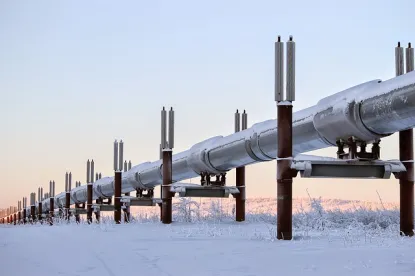Operators of underground storage facilities will need to assess the operational safety of their facilities and document the implementation of safety solutions.
For the first time, underground gas storage facilities will be subject to minimum federal safety standards that will set baseline fitness for service requirements and further states’ adoption and implementation of specific and consistent regulations that include operating procedures, monitoring, hazard identification, remediation, and emergency response and preparedness. Operators of such facilities will need to document implementation of the identified safety solutions and should expect that the Pipeline Hazardous Materials Safety Administration (PHMSA) will inspect their facilities to enforce the requirements.
Background
PHMSA has been implementing its expanded oversight authority under the Protecting our Infrastructure of Pipelines and Enhancing Safety Act of 2016 (PIPES Act). Section 12 of the PIPES Act requires PHMSA to issue minimum safety standards for underground natural gas storage facilities that
-
consider consensus standards for the operation, environmental protection, and integrity management of underground natural gas storage facilities;
-
consider the economic impacts of the regulations on individual gas customers;
-
ensure that the regulations do not have a significant economic impact on end users; and
-
consider the recommendations of the Aliso Canyon natural gas leak task force established under Section 31 of the PIPES Act.
While surface piping is subject to the Department of Transportation’s (DOT) safety regulations, downhole facilities such as wells, wellbore tubing, and casing, are not subject to Federal safety requirements. State standards apply to intrastate facilities. However, not all states have implemented safety standards and existing state standards may vary from state to state.
Adhering to Congress’ mandate in Section 12 of the PIPES Act, PHMSA has issued an Interim Final Rule that sets minimum federal safety standards for interstate and intrastate underground gas storage facilities. PHMSA explains that among the nearly 400 facilities nationwide, many wells are over 50 years old and were originally designed for petroleum production, which operate at different pressure levels, and were constructed with techniques designed for moving crude oil instead of gas. For example, these wells generally do not have a corrosion-resistant internal or external protective coating, which is required for all new pipelines. These factors increase the risk of leakage during a well’s lifetime, but the risk can be mitigated by an effective operations and maintenance program that includes reassessments and preventative and mitigation measures.
Although the PIPES Act gives PHMSA expanded oversight authority over underground natural gas storage facilities, it also allows state authorities to continue overseeing intrastate underground gas storage facilities. States will be able to continue adopting additional or more stringent regulations as long as they are consistent with the minimum federal standards.
New Minimum Federal Safety Standards
PHMSA is incorporating two recently adopted American Petroleum Institute (API) Recommended Practices (RP) into its federal pipeline safety regulations to address safety and environmental concerns of underground natural gas storage: API RP 1170, “Design and Operation of Solution-mined Salt Caverns used for Natural Gas Storage;” and API RP 1171, “Functional Integrity of Natural Gas Storage in Depleted Hydrocarbon Reservoirs and Aquifer Reservoirs.”
This stemmed, at least in part, from outreach by various organizations stressing the immediate need for PHMSA to adopt consensus standards for operators of underground storage facilities to follow in assessing their facilities and establishing procedures to ensure safety. Although the API RPs were released in the form of Recommended Practices and not Standards, PHMSA is now making them mandatory.
API RP 1170 covers facility geomechanical assessments, cavern well design and drilling, solution mining techniques and operations, including monitoring and maintenance practices. API RP 1171 focuses on storage well, reservoir, and fluid management for functional integrity in design, construction, operation, monitoring, maintenance, and documentation practices. These include activities in risk management, site security, safety, emergency preparedness, and procedural documentation and training to embed human and organizational competence in the management of storage facilities.
PHMSA participated in the development of these API RPs and, in February 2016, it issued an advisory bulletin recommending that underground natural gas storage facility operators review their operating, maintenance, and emergency response activities to ensure that they are maintaining the integrity of underground natural gas storage facilities. PHMSA advised operators to complete 12 actions items including
-
verifying that the pressure required to inject intended natural gas volumes does not exceed the design pressure limits of the reservoir, wells, wellheads, piping, casing, tubing, or associated facilities;
-
monitoring wells for annular gas or liquids periodically;
-
inspecting the wellhead assembly and attached pipelines for each of the wells used;
-
conducting periodic functional tests of surface and subsurface safety valve systems and wellhead pipeline isolation valve(s) for proper function and ability to shut off or isolate the well and remediate improperly functioning valves;
-
developing and implementing a corrosion monitoring and integrity evaluation program for piping, welling, easing, and tubing including the usage of appropriate well log evaluations; and
-
performing ongoing verification and demonstration of the integrity of the underground storage reservoir or cavern using appropriate monitoring techniques for integrity changes.
With the adoption of the API RPs through the Interim Final Rule, operators of underground gas storage facilities will need to assess the operational safety of their facilities and document how they implemented the safety solutions within as soon as six months of the effective date of the Interim Final Rule. They also may need to modify their normal business operations to comply with the API RPs. PHMSA and its state partners will monitor operators’ implementation of the requirements during the interim stage.
Once the requirements become effective, PHMSA will begin inspecting facilities to enforce the requirements. PHMSA plans to monitor and evaluate the safety of underground gas storage facilities and to incrementally build on the framework of the Interim Final Rule to ensure that operators fully address the safety issues presented by underground natural gas storage.
Operators may deviate from the API RPs if they provide sufficient technical and safety justification in their programs or procedural manuals on why compliance with a provision of the API RPs is not practical or necessary for the safety of the facility. Following compliance reviews of underground storage facility operations, PHMSA will notify operators of variances that should be avoided and will also incorporate lessons learned into inspection protocols and inspector training programs.
PHMSA also added reporting requirements for underground natural gas storage facilities to help ensure compliance with the minimum safety standards. Operators are required to submit
-
an annual report that provides general specifications, operational information, maintenance information of the facility;
-
an incident report for any event that involves the release of gas, death or personal injury necessitating in-patient hospitalization, estimated property damage of $50,000 or more, or unintentional estimated gas loss of three million cubic feet or more;
-
a safety-related condition report on findings that compromise the safety of the well or reservoir; and
-
National Registry information that identifies the facility operator with primary responsibility for operations through an assigned Operator Identification Number.
The Interim Final Rule is effective 30 days after publication in the Federal Register. Comments on the Interim Final Rule must be submitted within 60 days after publication in the Federal Register.




 />i
/>i
